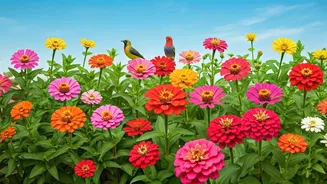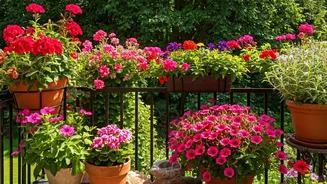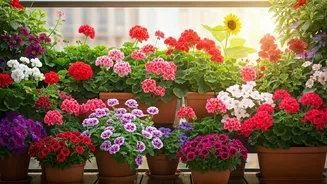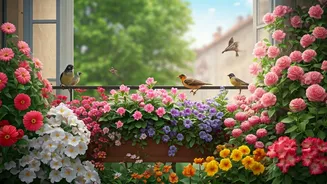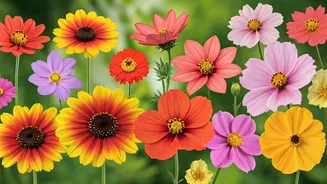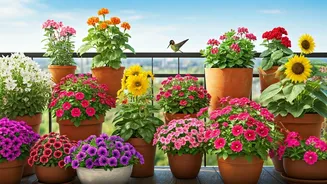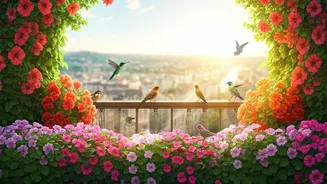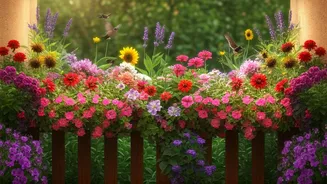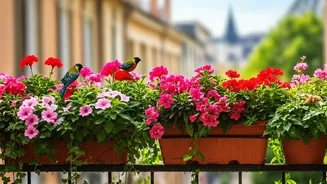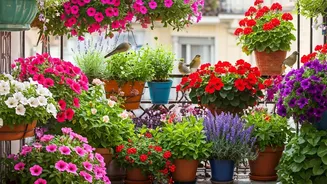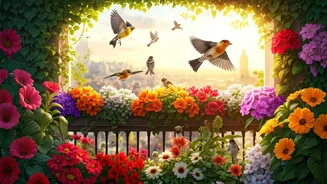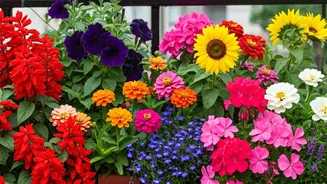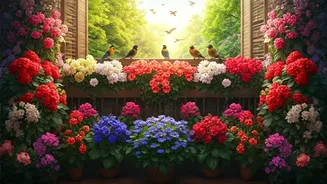Marigolds: Sunny Charms
Marigolds, with their bright hues, are a fantastic choice for attracting birds. These easy-to-grow flowers bring a splash of sunshine to any balcony garden,
available in various colors like yellow, orange, and red. They are relatively low-maintenance, thriving in full sunlight and well-drained soil, perfect for beginners in gardening. These vibrant blooms are not only aesthetically pleasing but also attract insects, providing a food source that birds enjoy. The seeds of marigolds are particularly appealing to certain bird species, making your balcony a potential feeding ground.
Petunias: Colorful Displays
Petunias are another excellent choice, known for their abundant blooms and diverse colors. These cascading flowers can be grown in pots or hanging baskets, adding a touch of elegance to any balcony space. They thrive in sunlight and well-drained soil, similar to marigolds. Petunias are excellent for attracting hummingbirds and other small bird species. Their nectar-rich flowers provide a valuable food source. Furthermore, planting petunias offers a visually appealing display, contributing to a more lively and welcoming balcony environment.
Sunflowers: Towering Beauties
Sunflowers, though requiring more space, can be a rewarding addition to a balcony garden. These towering plants bring a touch of the countryside to your urban space, and their seeds are a favorite among many bird species. Sunflowers need plenty of sunlight and well-drained soil. They also require more space than petunias or marigolds, so consider your balcony's dimensions. As sunflowers mature, their seed heads become a natural bird feeder, providing an essential food source, especially during colder months. This makes them a perfect choice for those wishing to encourage birds year-round.
Zinnias: Bold Hues
Zinnias offer a kaleidoscope of colors and are relatively easy to cultivate. They bring bold, vibrant hues to your balcony, attracting both birds and butterflies. Zinnias thrive in full sunlight and well-drained soil, similar to marigolds and petunias. They are relatively low-maintenance, making them a great choice for beginner gardeners. The brightly colored flowers attract various bird species. The seeds produced by zinnias are an excellent food source, contributing to your balcony's role as a haven for birds, encouraging them to visit and feed frequently.
Nasturtiums: Edible Delights
Nasturtiums are a unique addition to any balcony garden, offering both beauty and practicality. Their colorful flowers and leaves are edible, adding a touch of flavor to your salads. Nasturtiums are relatively low-maintenance, thriving in sunny locations with well-drained soil, making them suitable for most balconies. They not only attract birds but also deter pests. The flowers and leaves provide a food source for birds and offer a vibrant, aesthetically pleasing display. This makes nasturtiums a practical and attractive choice.
Lantana: Butterfly Magnet
Lantana is a versatile plant known for attracting butterflies and, indirectly, birds that feed on them. Its clusters of colorful flowers bloom throughout the year, adding a vibrant and continuous display to your balcony garden. Lantana thrives in full sunlight and well-drained soil, making it perfect for balconies. While lantana flowers provide nectar for butterflies and insects, attracting birds. Planting lantana contributes to the overall ecosystem of your balcony, creating a lively and diverse environment. Lantana can also be grown in pots and hanging baskets.
Salvia: Hummingbird Favorite
Salvia is highly attractive to hummingbirds, with its vibrant, tubular flowers. It's an excellent choice if you want to invite these tiny, fascinating birds to your balcony. Salvia varieties vary, but most thrive in full sunlight and well-drained soil. Regular watering is essential for successful growth. The nectar-rich flowers of salvia are a favorite food source for hummingbirds, ensuring they visit frequently. Growing salvia is a sure way to create a hummingbird-friendly environment, adding beauty and liveliness to your balcony.
Pansies: Cheerful Faces
Pansies offer cheerful faces and a wide range of colors. They thrive in cooler temperatures and can bloom throughout the fall and spring seasons, adding color during transition periods. Pansies prefer partial shade to full sun and well-drained soil. While not as directly attractive to birds as some other flowers, pansies contribute to a pleasant balcony environment. They are easy to grow and add visual appeal. The presence of pansies can indirectly support insect life, providing a food source that birds may enjoy.
Cosmos: Elegant Blooms
Cosmos are known for their graceful, daisy-like flowers and their ability to attract a variety of pollinators. These elegant blooms come in various colors, adding beauty and charm to any balcony. Cosmos prefer full sunlight and well-drained soil, making them relatively easy to grow. They are known to attract birds and beneficial insects, creating a balanced and lively ecosystem. The seeds of cosmos can also serve as a food source for some bird species, adding to the benefits of planting them in your balcony garden. Cosmos is a beautiful and effective way to invite nature to your balcony.
Lavender: Aromatic Haven
Lavender brings both fragrance and visual appeal to a balcony. Its beautiful purple flowers and soothing aroma provide a relaxing environment. Lavender thrives in full sunlight and well-drained soil. It's relatively drought-tolerant, which makes it suitable for balconies. While lavender may not directly attract birds in the same way as nectar-rich flowers, it helps deter pests. It brings a fragrant and calming element to your balcony space. Planting lavender contributes to creating a multi-sensory and bird-friendly environment.
